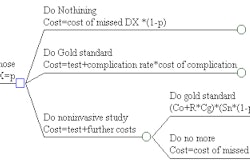SALT LAKE CITY - Korean interventional radiologists reviewed a decade’s worth of data on angiographic diagnosis of hepatocellular carcinoma (HCC) to come up with a comprehensive list of imaging pitfalls. Avoiding these pitfalls is especially vital when performing transcatheter arterial chemoembolization (TACE) for cancer treatment.
"During (TACE), we may miss tumors, overestimate a tumor extent or treat non-tumorous lesions," wrote Dr. Jin wook Chung in a poster presentation at the Society of Interventional Radiology meeting. Chung and co-authors are from the Seoul National University Hospital. To date, they have performed 10,000 TACE procedures, including catheter angiography, in 4,000 patients.
One pitfall that they described in detail is arterial hyperfusion due to angioinvasion, which can lead to the overestimation of tumor extent. The main finding is a homogenous stain, as on a portal hepatogram. On dual-phase CT, it is possible to identify parenchymal attenuation changes confined to the obstructed portal or hepatic vascular territory, they wrote.
Difficulty in recognizing hepatic artery variation is another issue. About one-fourth of patients have aberrant hepatic arteries from the celiac trunk, left gastric artery, and superior mesenteric artery or aorta. The small aberrant hepatic arteries are difficult to recognize on celiac arteriography. The group said they avoided this pitfall by routinely performing celiac and superior mesenteric arteriography and then evaluating the aberrant left hepatic artery, starting from the left gastric artery.
Another pitfall is caused by a nontumorous arterioportal shunt. "It frequently mimics nodular HCC on spiral CT and can be associated with true HCC nodules in other locations," they explained.
Some of the other pitfalls that they catalogued were as follows:
- Hidden foci under the gastric and splenic stain.
- Failed segmental localization of tumors.
- Arterial hyperfusion due to portal or hepatic vein obstruction.
- Non-visualization of tumor vascularity due to collateral circulation or reversed flow in celiac axis stenosis.
- Overlapping lesions.
- Systemic hypervascularization of the lung via right inferior phrenic artery.
- Partial extrahepatic collateral supply at initial presentation or during repeated chemoembolization.
Technical difficulties also can arise, such as an insufficient amount of angiographic contrast agent or a wedged injection of contrast agent. The latter occurs when the contrast agent is forcefully injected with a catheter wedged to a branch vessel. This can cause intense parenchymal stain, which mimics diffuse tumor stain.
Another technical issue is related to transhepatic intrajugular portosystemic shunt (TIPS) and HCC. TIPS can induce diffuse arterioportal shunting in the entire liver. After TIPS, tumor stain can be obscured on hepatic arteriography, they wrote. In addition, interventional radiologists should watch out for hemodynamic changes after TIPS.
"Recognition of these pitfalls may lead to safe and effective chemoembolization," they concluded.
By Shalmali Pal
AuntMinnie.com staff writer
March 29, 2003
Copyright © 2003 AuntMinnie.com



















